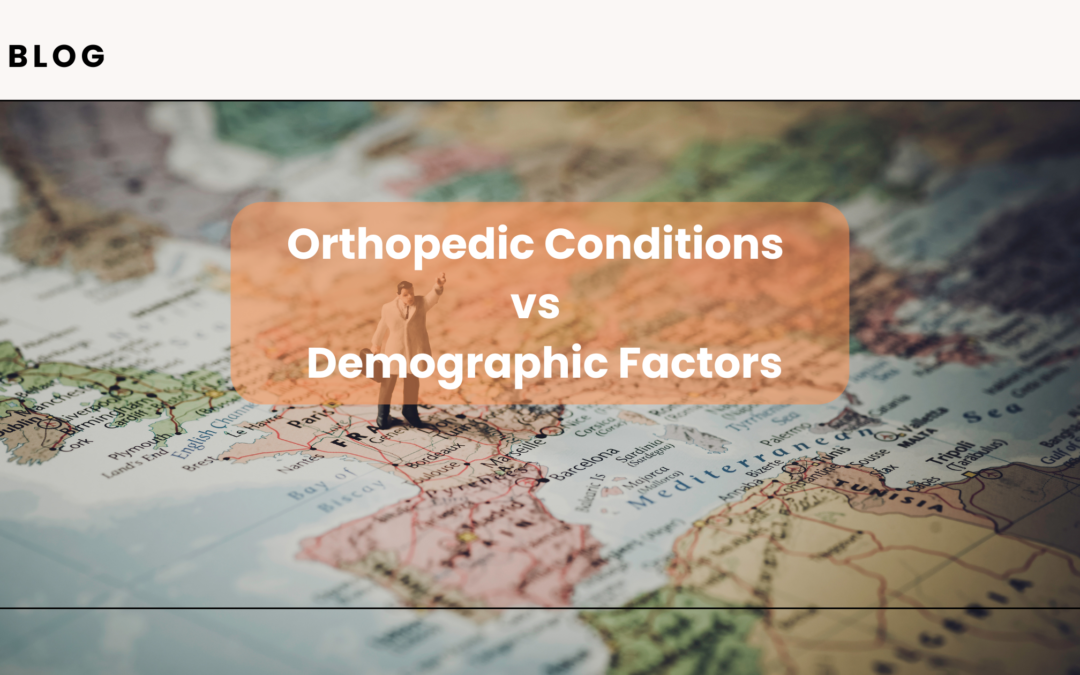Orthopedic Conditions Vs Various Demographic Factors
Orthopedic conditions can be influenced by various demographic factors, including geographical location, lifestyle, and even climate. Here are some orthopedic conditions that may be more prevalent in specific demographics based on where they live:
Knee Osteoarthritis
Demography: More common in older adults and individuals living in areas requiring high levels of physical activity (e.g., hilly regions).
Causes: Overuse and wear-and-tear of the joint due to activities like walking or hiking on uneven terrain.
Hip Osteoarthritis:
Demography: Often found in older adults, particularly in urban settings where people may lead more sedentary lifestyles with sporadic high-impact activities.
Causes: Joint degeneration can be exacerbated by obesity and lack of regular, moderate exercise.
Sports Injuries:
Demography: Younger populations, particularly in areas with access to sports facilities or outdoor activities (such as regions with mountains or lakes).
Causes: Common injuries include sprains, strains, fractures, and tendon injuries from activities like running, climbing, or playing sports.
Ankle Sprains:
Demography: Individuals in hilly or rugged terrains, as the instability of the ground increases the risk of such injuries.
Causes: Navigate uneven surfaces can lead to twisting motions that result in sprained ankles.
Lower Back Pain:
Demography: Common across various demographics but may vary with occupation (e.g., labor-intensive jobs in rural areas).
Causes: Can stem from prolonged sitting, lifting heavy objects, or poor posture, exacerbated by lifestyle factors unique to certain regions.
Tendinitis: (e.g., Achilles tendinitis):
Demography: More prevalent among individuals involved in regular running or strenuous activities in rural or hilly areas.
Causes: Overuse and repetitive motions often associated with sports and outdoor activities.
Skiing- and Snowboarding-related Injuries**:
Demography: Individuals living in mountainous areas or regions with snow sports.
Causes: High impact and falls can lead to fractures, ligament tears, and soft tissue injuries.
Osteoporosis:
Demography: Common in postmenopausal women and older individuals, particularly in climates with limited sunlight exposure.
Causes: Lifestyle factors like low physical activity and poor dietary calcium can contribute, affecting bone density and increasing fracture risk.
Carpal Tunnel Syndrome:
Demography: More common in individuals in urban areas or those engaged in repetitive wrist-use occupations (e.g., office workers, two-wheeler drivers).
Causes: Repetitive motions and prolonged computer use can lead to nerve compression in the wrist.
Rheumatoid Arthritis:
Demography: Certain genetic and environmental factors may lead to higher rates in specific populations, although not strictly linked to geography.
Causes: Autoimmune factors can lead to joint inflammation, which is not directly influenced by geographic location but may be affected by lifestyle and access to healthcare.
In conclusion, recognizing the impact of demographic factors on orthopedic conditions is essential for effective healthcare strategies. By understanding how geographical location, lifestyle choices, and climate can influence the prevalence of these conditions, medical professionals can better identify at-risk populations and develop targeted preventive measures. Maana Health’s tailored approach enhances patient outcomes and fosters a proactive stance on health education and intervention. We ensure that individuals receive the appropriate care utilizing advanced and modern modalities. If you’re struggling with any of the above conditions, Contact Maana Health at +91 99950 89400.

